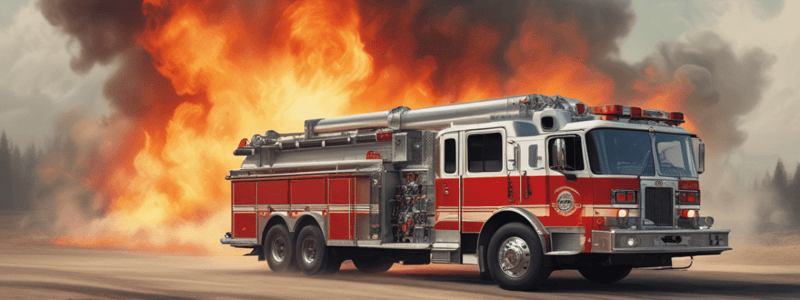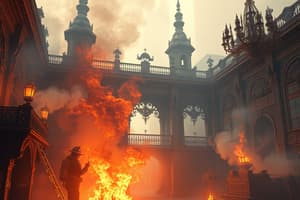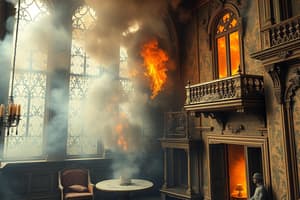Podcast
Questions and Answers
What was the reason for the fire officers in the 1970s to believe that reading smoke couldn't be taught?
What was the reason for the fire officers in the 1970s to believe that reading smoke couldn't be taught?
- They felt it was based on experience and intuitiveness (correct)
- They believed it required extensive training
- They thought it was too complex to be taught
- They didn't see the value in teaching it
What has contributed to a more volatile fire environment today?
What has contributed to a more volatile fire environment today?
- Increased fire department response times
- Increased fire officer experience
- Low-mass synthetics and the consumer trend toward 'big box' purchasing (correct)
- Reduced fire department budgets
What is one of the benefits of a fire officer being able to rapidly read smoke?
What is one of the benefits of a fire officer being able to rapidly read smoke?
- They can determine the exact time of fire ignition
- They can determine the exact location of the fire's origin
- They can make better decisions about aggressive attack or search and rescue priorities (correct)
- They can determine the exact number of people involved
What is NOT one of the key attributes of smoke?
What is NOT one of the key attributes of smoke?
What can a comparative analysis of smoke attributes help fire officers determine?
What can a comparative analysis of smoke attributes help fire officers determine?
Why do fire officers need to break the 'heavy smoke or light smoke' mentality?
Why do fire officers need to break the 'heavy smoke or light smoke' mentality?
What is necessary to understand before analyzing the meaning of each smoke attribute?
What is necessary to understand before analyzing the meaning of each smoke attribute?
Why is it important to teach fire officers how to read smoke?
Why is it important to teach fire officers how to read smoke?
What is the primary reason why smoke is extremely flammable?
What is the primary reason why smoke is extremely flammable?
What is the result of a fire officer focusing on the open flames to determine tactics?
What is the result of a fire officer focusing on the open flames to determine tactics?
What is the term for a fire that does not allow open flaming to complete a reaction with pure air?
What is the term for a fire that does not allow open flaming to complete a reaction with pure air?
What is the effect of ignition of smoke that has pressurized a room or 'box'?
What is the effect of ignition of smoke that has pressurized a room or 'box'?
What is the primary purpose of understanding the four attributes of smoke?
What is the primary purpose of understanding the four attributes of smoke?
What is the term for the heat from flaming being absorbed through materials, leading to off-gassing without flaming?
What is the term for the heat from flaming being absorbed through materials, leading to off-gassing without flaming?
What is the effect of a fire officer opening the front door of a ventilation-limited fire?
What is the effect of a fire officer opening the front door of a ventilation-limited fire?
What is the term for the speed and flow characteristic of smoke that leaves a building?
What is the term for the speed and flow characteristic of smoke that leaves a building?
What is the result of a small fire in a compartmentalized space with low-mass contents?
What is the result of a small fire in a compartmentalized space with low-mass contents?
What is the primary difference between a hot, clean-burning fire and a hot, fast-moving fire in an 'underventilated' building?
What is the primary difference between a hot, clean-burning fire and a hot, fast-moving fire in an 'underventilated' building?
What is the significance of considering the building size while analyzing smoke observations?
What is the significance of considering the building size while analyzing smoke observations?
How can firefighters practice reading smoke in an environment with fewer fires?
How can firefighters practice reading smoke in an environment with fewer fires?
What is the primary goal of reading smoke?
What is the primary goal of reading smoke?
What is the benefit of vocalizing smoke attributes while observing them?
What is the benefit of vocalizing smoke attributes while observing them?
What is the significance of 'vent, control, and search' in firefighting?
What is the significance of 'vent, control, and search' in firefighting?
Why is it important for firefighters to move 'reading smoke' up the training priority list?
Why is it important for firefighters to move 'reading smoke' up the training priority list?
What is the relationship between reading smoke and tactical decision-making?
What is the relationship between reading smoke and tactical decision-making?
What can firefighters learn from observing smoke from a restaurant grease hood, fireplace chimney, or smoke stack?
What can firefighters learn from observing smoke from a restaurant grease hood, fireplace chimney, or smoke stack?
What is smoke velocity an indicator of in a building?
What is smoke velocity an indicator of in a building?
What are the two things that can cause smoke to pressurize within a building?
What are the two things that can cause smoke to pressurize within a building?
What type of smoke flow is caused by rapid molecular expansion of the gases within the smoke?
What type of smoke flow is caused by rapid molecular expansion of the gases within the smoke?
What does the velocity of smoke at different openings of the building help the fire officer determine?
What does the velocity of smoke at different openings of the building help the fire officer determine?
What is the most important smoke observation for a fire officer?
What is the most important smoke observation for a fire officer?
What does the thickness of smoke indicate?
What does the thickness of smoke indicate?
What is a consequence of thick, black smoke within a compartment?
What is a consequence of thick, black smoke within a compartment?
What is a characteristic of smoke-cloud ignition?
What is a characteristic of smoke-cloud ignition?
What is a limitation of using smoke color to determine the type of material that is burning?
What is a limitation of using smoke color to determine the type of material that is burning?
What is a characteristic of turbulent smoke?
What is a characteristic of turbulent smoke?
What is the primary reason why smoke color changes as a material burns?
What is the primary reason why smoke color changes as a material burns?
What does white smoke typically indicate?
What does white smoke typically indicate?
What is the significance of brown smoke in a fire?
What is the significance of brown smoke in a fire?
What is the term used to describe smoke that is high-volume, turbulent velocity, ultra-dense, and black?
What is the term used to describe smoke that is high-volume, turbulent velocity, ultra-dense, and black?
What is the primary reason why smoke color changes as it travels from the source of the fire?
What is the primary reason why smoke color changes as it travels from the source of the fire?
What does grey smoke typically indicate?
What does grey smoke typically indicate?
What is the significance of smoke velocity in determining the location of a fire?
What is the significance of smoke velocity in determining the location of a fire?
What is the primary reason why firefighters should treat black fire as if it were actual flames?
What is the primary reason why firefighters should treat black fire as if it were actual flames?
What does uniform smoke color and velocity from multiple openings indicate?
What does uniform smoke color and velocity from multiple openings indicate?
What is the primary reason why engineered wood products like OSB and LVL lose strength when heated?
What is the primary reason why engineered wood products like OSB and LVL lose strength when heated?
Flashcards are hidden until you start studying
Study Notes
Reading Smoke
- Reading smoke is a skill that helps fire officers predict fire behavior and make better tactical decisions.
- The ability to read smoke has been around for decades, but it's a skill that is not being taught or practiced enough.
Understanding Smoke
- Smoke is an aggregate of solids, aerosols, and fire gases that are toxic, flammable, and volatile.
- Solids include carbon, ash, dust, and airborne fibers.
- Aerosols include hydrocarbons (oils/tar).
- Fire gases include carbon monoxide, hydrogen cyanide, acrolein, hydrogen sulfide, and benzene.
- Hot smoke is extremely flammable and will ultimately dictate fire behavior.
Fire Behavior
- Within a building, heat from flaming is absorbed through materials, which break down and begin off-gassing without flaming (pyrolysis).
- This leads to an underventilated fire, which doesn't allow open flaming to complete a reaction with pure air.
- The smoke is looking to complete what was started, and two triggers (the right temperature and the right mixture) may cause the smoke to ignite.
Attributes of Smoke
- Volume: tells us about the amount of fuels that are "off-gassing" within a given space.
- Velocity: indicates pressure that has built up within the building and can help determine the location of the fire.
- Density: tells us how bad things are going to be, with thicker smoke indicating more fuel and a higher risk of flashover.
- Color: indicates the stage of heating and can help find the location of the fire within a building.
Smoke Velocity
- Velocity is an indicator of pressure, and can help determine the location of the fire.
- Faster smoke will be closer to the fire seat.
- Comparing velocity at different openings can help determine the location of the fire.
Smoke Density
- Density tells us how much fuel is laden in the smoke.
- Thicker smoke will spread a fire event (like flashover) farther than less dense smoke.
- Thick, black smoke within a compartment reduces the chance of life sustainability.
Smoke Color
- Smoke color indicates the stage of heating and can help find the location of the fire within a building.
- White smoke indicates early-stage heating, while black smoke indicates late-stage heating.
- Brown smoke indicates that the fire is transitioning from a contents fire to a structural fire.
Practicing the "Reading Smoke" Skill
- Practice reading smoke by observing raw fireground video footage or watching smoke from a restaurant grease hood, fireplace chimney, or smoke stack.
- Vocalize volume, velocity, density, and color observations to improve recognition speed.
- Reading smoke is not a tactic but a tool to help make better tactical choices.
Studying That Suits You
Use AI to generate personalized quizzes and flashcards to suit your learning preferences.




